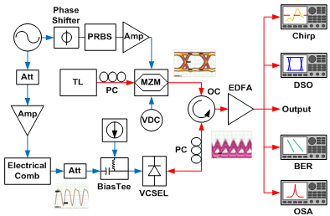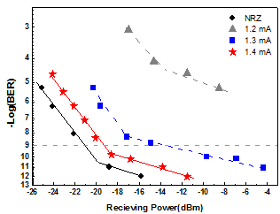 |
Low Loss Terahertz Air-Core Pipe Waveguides
Professor
Chi-Kuang Sun
Graduate Institute of Photonics and
Optoelectronics, National Taiwan University
台湾大学光电所 孙启光教授
Terahertz (THz) technology has
high potential in a wide variety
of applications ranging from
high-speed telecommunications to
bio-imaging. To facilitate THz
applications, it is essential to
develop low-loss and low-cost
THz waveguides. Recently, we
proposed a dielectric circular
air-core pipe for low-loss THz
waveguiding. The pipe waveguide
is the simplest pipe with a
large air core region surrounded
by thin and low-index dielectric
cladding. Without complex
fabrication, we used commercial
Teflon pipes to demonstrate that
the circular pipe waveguides not
only possess low attenuation
constants (< 0.001 cm-1)
and high coupling efficiency (>
80%), but also suffer low
bending loss. By modifying the
circular pipe waveguides into
rectangular ones, we further
removed the transmission
degeneracy of two orthogonal
polarizations. It is expected
that these easily available, low
loss, low bending loss, and
polarization-sensitive THz
waveguides would have a high
potential for THz sensing,
communication, and imaging
applications.
Beyond-Bandwidth Electrical Pulse Modulation of
a TO-Can Packaged VCSEL for 10 Gbit/s
Injection-Locked NRZ-to-RZ Transmissions
Professor
Gong-Ru Lin
Graduate Institute of Photonics and
Optoelectronics, National Taiwan University
台湾大学光电所 林恭如教授
A TO-46-can packaged VCSEL with
a finite bandwidth of only 3 GHz
has been employed to demonstrate
a 10-Gbit/s all-optical
NRZ-to-RZ data-format convertor,
as shown in Fig. 1. This
approach is based on the
injection-locking induced
gain-switching and the
beyond-bandwidth
electrical-pulse modulation of
the TO-46-can packaged VCSEL
biased at nearly lasing
condition. To support 10-Gbit/s
RZ data pulse generation, the
resonant relaxation oscillation
frequency of this TO-46-can
packaged VCSEL is increased
through direct modulation by an
electrical-pulse at 10 GHz and
external NRZ optical injection
from 2 to at least 7.3 GHz. The
optimized 10-Gbit/s RZ
data-stream exhibits the signal
to noise ratio, the timing
jitter, and the pulsewidth of
7.2 dB, 2.9 ps, and 27 ps,
respectively. The peak-to-peak
chirp and corresponding chirp
parameter are slightly raised to
4.3 GHz and 122 MHz/ps by
increasing the injection power
and the biased current. Owing to
carrier accumulation and gain
variation, the RZ data
pulsewidth gets reduced by
increasing the optical NRZ
injection power and concurrently
increasing the DC biased
current.
A higher DC biased current
further promotes the RZ data
with greater modulation depth
and sharper shape. A BER of 10-9
at 10 Gbit/s is achieved at a
receiving power of -19.5 dBm,
and an improvement of receiving
power penalties up to 16 dB is
observed when the DC biased
current is reduced to only 10%
of its lasing threshold, as
shown in Fig. 2. In particular,
the slope of the BER versus
receiving power significantly
changes at a receiving power of
>-19 dBm. The major reason for
the slope change in the BER
curves is crosstalk between the
reflected incoming optical NRZ
injection and the output of the
VCSEL converted RZ data-stream.
With a limited receiving
sensitivity of the 10-Gbit/s
lightwave receiver (Agilent
83434A), the VCSEL converted RZ
data-stream inevitably
introduces a noise floor in its
BER response. Despite the finite
bandwidth set by the homemade
VCSEL, this work demonstrates
the feasibility of operating the
TO-can packaged VCSEL based RZ
generator beyond its intrinsic
modulation bandwidth with the
aid of electrical-pulse
modulation and externally
optical injection. Most concerns
regarding the noisy data-stream
output can be addressed if the
VCSEL can tolerate a larger bias
and thereby achieve a better SNR
before breakdown.
|
 |
 |
|
Fig. 1. VCSEL based 10-Gbit/s NRZ-to-RZ
convertor. Amp: microwave amplifier;
MZM: Mach-Zehnder modulator; OC: optical
circulator; PC: polarization controller;
TL: tunable laser; Att: attenuator; DSO:
Digital Sampling Oscilloscope; BER: bit
error rate tester; OSA: optical spectrum
analyzer.
|
Fig. 2 BER analysis of the optical NRZ
from a externally modulated VCSEL
without injection (black), and the
generated RZ at 10 Gbit/s from the
injection-locked VCSEL at DC bias of
1.2, 1.3, and 1.4 mA. |
Reference:
Chia-Chi Lin, Yu-Chieh Chi, Hao-Chung
Kuo, Peng-Chun Peng, Connie
Chang-Hasnain, and
Gong-Ru Lin,
“Beyond-Bandwidth
Electrical-Pulse Modulation of a
TO-can Packaged VCSEL for 10 Gbit/s Injection-Locked
NRZ-to-RZ Transmission,” Journal
of Lightwave Technology, Vol.
29, Issue 6, pp. 830-841, Mar.
2011.
|
 |